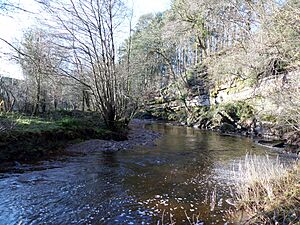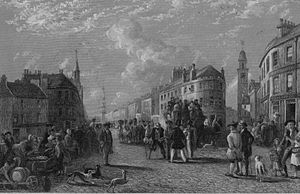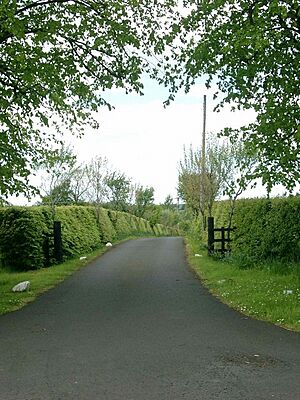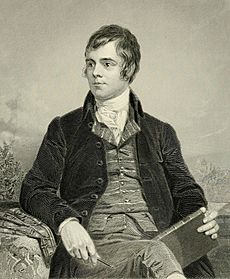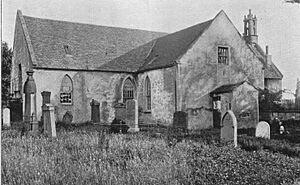John Goldie (philosopher) facts for kids
Quick facts for kids
John Goldie
|
|
|---|---|
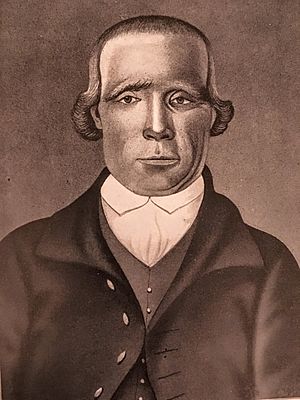
John Goldie, philosopher
|
|
| Born | 1717 Craig Mill, East Ayrshire, Scotland
|
| Died | 1811 (aged 93–94) Kilmarnock, Scotland
|
| Occupation | miller cabinet maker wine merchant philosopher mathematician astronomer theologian |
John Goldie (1717–1811) was a clever Scottish man known as 'the Philosopher'. He was a good friend of the famous poet Robert Burns. John Goldie was born in a small village called Craigmill in East Ayrshire, Scotland.
He worked as a miller, a cabinet maker, and later a wine merchant. He was also very interested in many subjects like maths, space (astronomy), and religion. He wrote several books, and one of them, published in 1780, was very popular. It was called Essays on various Important Subjects Moral and Divine. People often called it 'Goudie's Bible'. This book made him famous across Scotland.
Contents
The life of John Goldie
John Goldie was born in 1717 at Craigmill, a flour mill. His family had worked at this mill for almost 400 years! His parents were Anna Farquhar and John Goudie. They got married in 1714. John had four brothers and sisters.
People often called him 'the philosopher' because he thought deeply about many things. He was seen as "one of the most remarkable men of his time." The old mill where he grew up was taken down by 1908.
When he was 14 years old, in 1735, John built a tiny corn mill. He used simple tools and materials. A local gentleman, Mr. Wallace, was very impressed by his clever design. He even brought a powerful nobleman, the Earl of Marchmont, to see it. The Earl gave John three shillings to buy a special iron part for his mill.
John later moved to Kilmarnock. He became a cabinet maker, even though he hadn't officially trained for it. After that, he became a successful wine and spirit merchant. He had a big, popular shop in Kilmarnock. He also invested money in new projects like canals, railways, and coal mines.
As a cabinet maker, he made a beautiful, fancy clock case from mahogany wood. It was so artistic that most people couldn't afford it. But the Duke of Hamilton heard about it and bought it for £30. This was a lot of money back then! The Duke put the clock case in his grand home, Hamilton Palace.
John Goldie learned a lot from his mother, Anna. He also taught himself by reading many books. He loved to study from a young age and learned about "some of the more difficult sciences."
He grew up with strong religious beliefs, but he also liked to think for himself. He would often walk 20 miles every Sunday to hear a special minister preach. He had read a book that made him question some traditional religious ideas.
People said John Goldie was a very honest and good person. He had many friends, including important people in Kilmarnock. He also wrote letters to famous writers of his time.
John Goldie's books
There's a bit of confusion about the exact dates and names of his books. His first book was printed in Glasgow. It was called Essays on various Important Subjects Moral and Divine. In this book, he shared his different ideas about religion. These ideas worried some of the more traditional religious groups.
In 1785, he published a second edition of his book. In 1786, he published The Gospel Recovered from its Captive State. This book showed how much he disagreed with the very traditional religious views he once supported.
In 1808, he had a book printed in Kilmarnock called Conclusive Evidences Against Atheism. His last book, published in 1809, was A Treatise upon the Evidences of a Deity. He was still working on a book about astronomy when he died.
The Beanscroft Devil mystery
There's a strange story about John Goldie and something called the 'Beanscroft Devil'. This happened around the time of the poet Robert Burns.
Beanscroft Farm was in East Ayrshire, a few miles from Kilmarnock. The farmer there was known as a good, honest, and religious man. But strange things started happening at his farmhouse and in the barns. He and his family slowly became convinced that the Devil himself was bothering them.
At first, it was small things like sounds and movements that could be blamed on the wind or a cat. But then furniture started moving, and there were strange shrieks and howls. Even stranger, lights of different colors appeared, and the ropes holding the cattle broke without being cut. These things were very hard to explain! The farmer's son tried to solve the mystery, but his parents were too scared to leave the farmhouse.
John Goldie, the 'Philosopher', believed in God but didn't think the Devil was walking around on Earth. He said he could solve this mystery using logic, like a detective. The farmer, though unsure, invited John Goldie to the farm. John brought his friends, a minister named Mr. Gillies and a merchant named Robert Muir.
John Goldie asked questions about possible enemies and looked at the broken ropes. He then said that this was the work of a person, not the Devil. He made the farmer promise to keep a secret. He told the farmer to hide in the barn that night.
When it got dark, the farmer hid as he was told. He soon heard the strange noises again. Suddenly, he saw a shadowy figure holding a trumpet-like object. This person was making the scary sounds! The farmer rushed forward and grabbed the person. To his surprise, it was his own son!
It turned out the son knew a bit about chemistry. He had made what we now call colored fireworks. He had also used a strong acid, then called Aqua Fortis (meaning 'strong water'), to cut the ropes. John Goldie had figured out that the son was trying to scare his father into retiring so he could take over the farm.
John Goldie's reputation as a smart thinker grew even more. The son was so ashamed that he left the area and was never seen there again.
John Goldie and Robert Burns
John Goldie was 40 years older than Robert Burns. They were good friends. In 1785, after a new edition of 'Goudie's Bible' came out, Burns wrote a poem called Epistle to John Goldie.
Here are some lines from the poem:
|
In this poem, Burns called Goldie "Terror o' the Whigs." A "Whig" here meant a very traditional religious person. Burns was praising Goldie for challenging these traditional ideas.
It is said that Goldie visited Robert Burns in 1785 at Mossgiel Farm. They sat down together, and Burns read some of his poems aloud. Goldie had first heard about Burns through handwritten copies of his poems.
Goldie was so impressed by Burns's poetry that he encouraged him to publish his work. He even helped Burns by promising the printer, John Wilson, that he would pay if Burns couldn't. This helped Burns publish his first book, Poems, Chiefly in the Scottish Dialect.
Burns often visited Goldie's home. There, he met many important people from Kilmarnock. These included the Town-clerk, Mr. William Paterson; Mr. Robert Muir, a wine merchant; and Major Parker, a banker. Burns became friends with many of these leading figures. During these visits, Burns would read his poems. Everyone agreed to help pay for his poems to be published. Many of these supporters later bought copies of his book.
It's said that Goldie told Burns, "Robin, I'll tell you what to do. Come down to Killie (Kilmarnock) next week, and have dinner with me. I have a few good friends who can help get your book printed." Researchers believe Goldie was very important in convincing Burns to publish his poems.
Some historians believe that Goldie also strongly influenced Robert Burns not to move to Jamaica.
Burns visited Goldie's house every day in 1786 while his poems were being printed. He corrected the proofs there and wrote many letters. He also met future supporters who would buy his first published book. Goldie lived in a flat above a shop. Next door was another flat where Burns sometimes worked on his proofs and listened to Mrs. Gregory play the piano.
A local historian noted that the printing shop where Burns's poems were published used to belong to John Goldie, his friend and supporter.
Two other poets, David Sillar and Gavin Turnbull, also wrote poems about John Goldie. Turnbull wrote:
|
Goldie's son, Lieutenant Goldie, later remembered how Burns looked and acted when he first knew him. He also recalled how much Burns changed after he became famous in Edinburgh.
It seems that John Goldie's writings had a big effect on Robert Burns's ideas. These influences can be seen in several of Burns's poems.
Sadly, many of Goldie's important papers, including letters from Burns and other famous people, were lost. This happened when his son was away at sea. Because of this, Goldie's importance might have been forgotten a bit over time.
Interesting facts
- 'Goudie's Bible' was sometimes made fun of by his critics. Once, in Ayr, he was going into a bookshop. A clergyman he knew was leaving with some books. Goldie asked him what he had bought. The clergyman replied, "Just buying a few songs to make psalms for your bible." This was a joke about Goldie's different religious views.
- John Goldie was very interested in building a canal from Kilmarnock to Troon. He even explored a good path for it. In 1796, the Kilmarnock Council thought about asking the government to build this canal.
- It is said that he lost money in mining investments. He was cheated by his business partner later in his life.
- A painting of John Goldie was made by Mr. Whitehead. It is said to be a very good likeness of him. In the background of the painting, there is a globe.
See also
- Haining Place and the Barony of Haining-Ross
- Robert Burns and the Eglinton Estate
- Robert Muir of Loanfoot
- Poems, Chiefly in the Scottish Dialect
- Poems, Chiefly in the Scottish Dialect (Edinburgh Edition)


